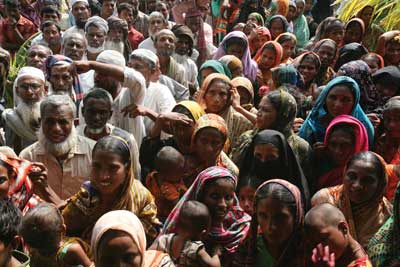 A political science professor considers the range of possible human responses to future climate crises.
A political science professor considers the range of possible human responses to future climate crises.
Sophisticated meteorological models predict a future with dramatically different snowfall accumulations, rainfall patterns, weather events, sea levels and temperatures—even in the best-case scenarios. What’s missing from these models is a human component. Where will people be living in this climatically altered world?
 Two UO-affiliated political scientists, John Orbell and Oleg Smirnov, are leading an interdisciplinary team of six researchers on a joint project between the UO and Stony Brook University in New York to address this question. With support from the National Science Foundation to the tune of $1.5 million, the team plans to create computer models of the potential responses of all human populations (that’s about 7 billion responses) to climate change.
Two UO-affiliated political scientists, John Orbell and Oleg Smirnov, are leading an interdisciplinary team of six researchers on a joint project between the UO and Stony Brook University in New York to address this question. With support from the National Science Foundation to the tune of $1.5 million, the team plans to create computer models of the potential responses of all human populations (that’s about 7 billion responses) to climate change.
For the preliminary model, the team will choose one or two climate events (such as drought and sea level rise), identify those populations likely to be most affected and then—using mathematical equations, GIS tools, human behavior models and basic research—model how the populations might react.
While individual responses to climate stress will doubtless involve numerous variations, Orbell believes populations as a whole will have broadly predictable responses that fall into three general categories: 1) stay and get innovative, 2) stay and get resource greedy (fight) or 3) migrate, which could entail conflict with those populations in targeted destinations.
Orbell, a professor emeritus of political science at the UO, and Smirnov, a previous student of Orbell’s who now is a professor of political science at Stony Brook, are not the first social scientists to consider how populations may respond to changing climates. But the majority of other research on the subject has been qualitative and more often related to localized populations.
Orbell and Smirnov’s proposal stands out due to the global scale of their inquiry and the quantitative computer modeling they plan to use. The project will involve state-of-the-art GIS technology and mathematical modeling tools, and will follow a formal scientific approach for running simulations.
To the challenge that human behavior defies prediction and is too complex to model, Orbell counters the same could be said of the world’s climate, which continues to be modeled with growing accuracy. “I’m not sure human behavioral systems are any more complex than our climate or ecological systems,” he said. However, he emphasizes their model will be very basic. “It’s taken climatologists 30 years to get where they are. Our efforts are only the first step toward predicting complicated human responses,” he said.
Orbell and Smirnov both hope the model and associated equations will create the foundation for subsequent work of the same kind—by themselves, but also others.
They will be joined in the project at the UO by Amy Lobben (see profile, page 6), an associate professor of geography, and Doug Kennett, an associate professor of anthropology. From Stony Brook, Minghua Zhang, director of the Institute for Terrestrial and Planetary Atmospheres, and Haipeng Xing, assistant professor of applied mathematics and statistics, will be lending their expertise.
Despite the depressing nature of the work—the impact of climate change on many human societies will likely be devastating, especially in geographically at-risk poor countries—Orbell believes their efforts to scientifically anticipate potential consequences of abrupt climate change will shed a ray of light onto a future we are otherwise marching toward in the dark.
“By exposing the possible scenarios of where people might move and what resources they might need, we are at least preparing ourselves to deal with a global crisis,” said Orbell. “A necessary condition for human civilization to survive is knowledge.”
— Patricia Hickson




 A new course will provide UO students with mobile smart phones and a mission: to build smart-phone apps.
A new course will provide UO students with mobile smart phones and a mission: to build smart-phone apps.
 Two CAS faculty members have been honored with the 2011 UO MLK Award.
Two CAS faculty members have been honored with the 2011 UO MLK Award. Petrarch is not only going digital at the UO, but musical as well.
Petrarch is not only going digital at the UO, but musical as well.